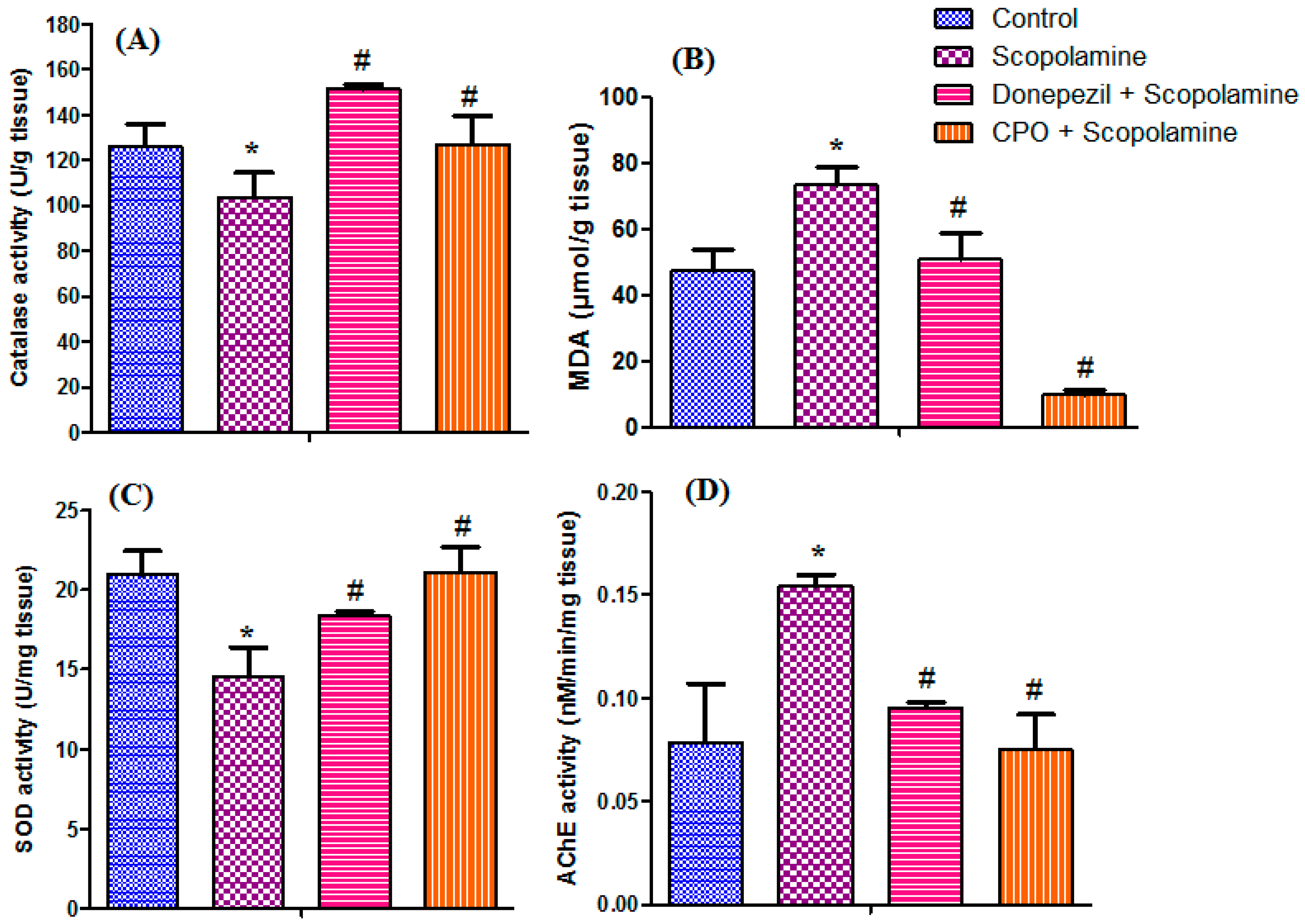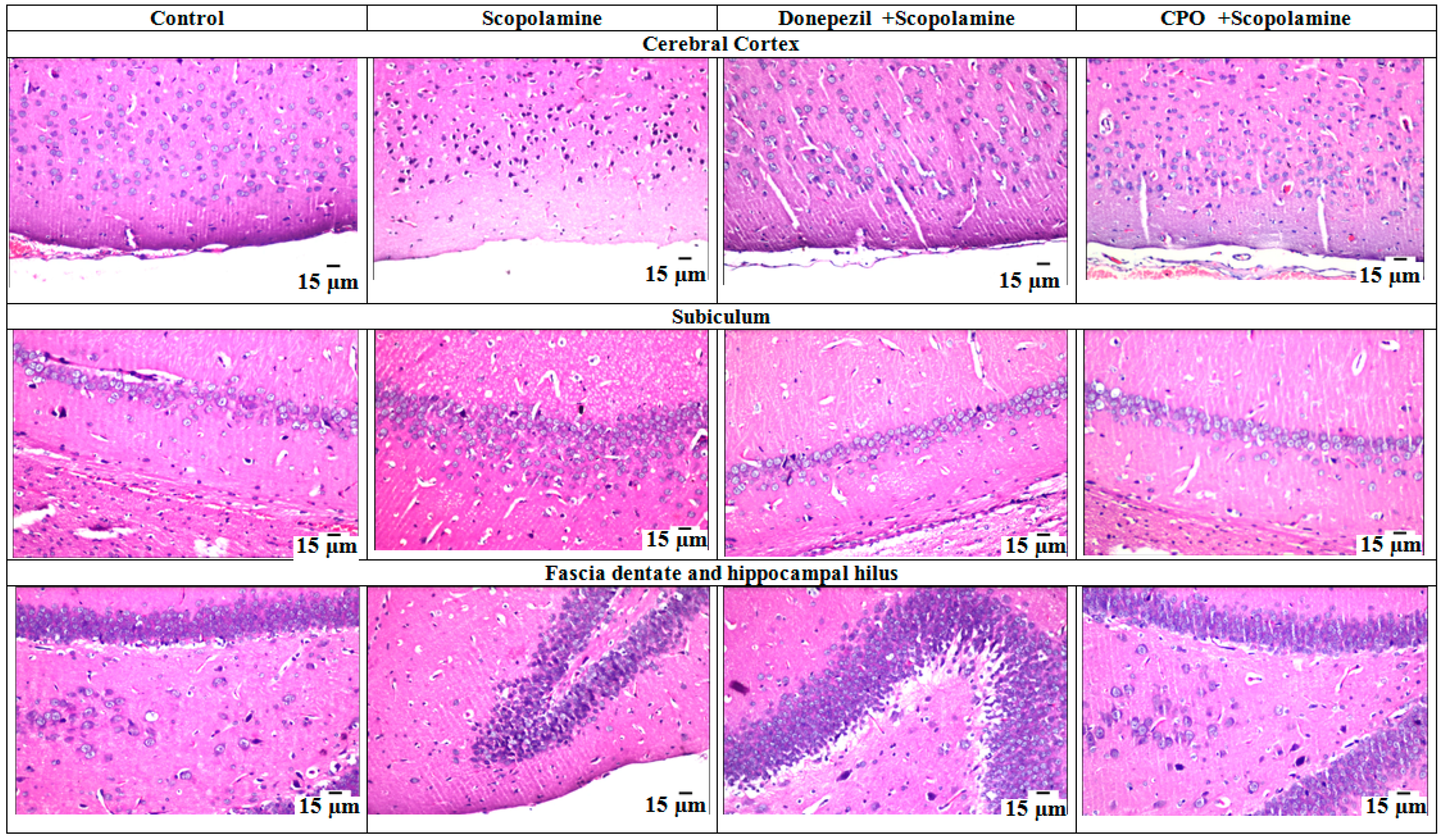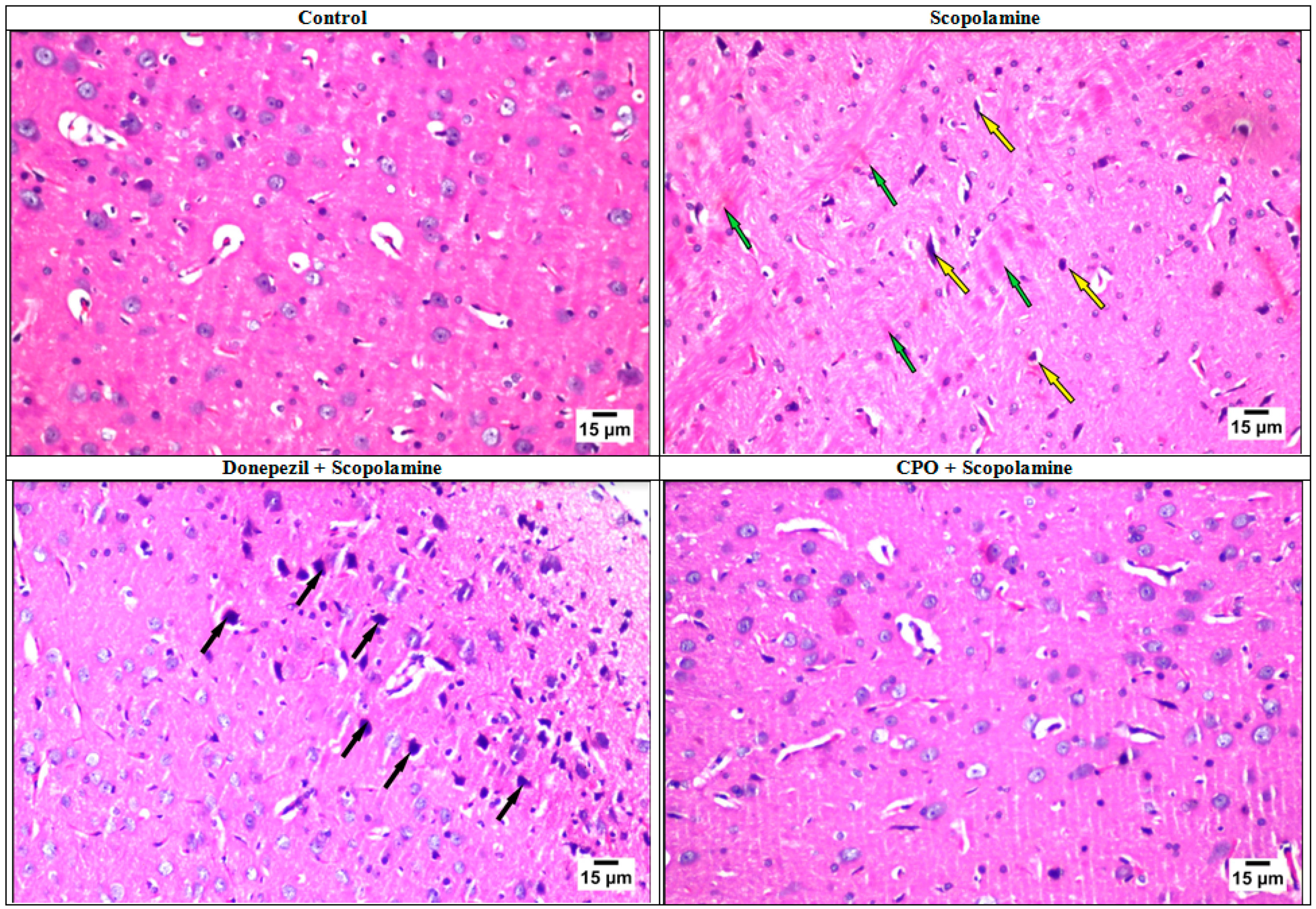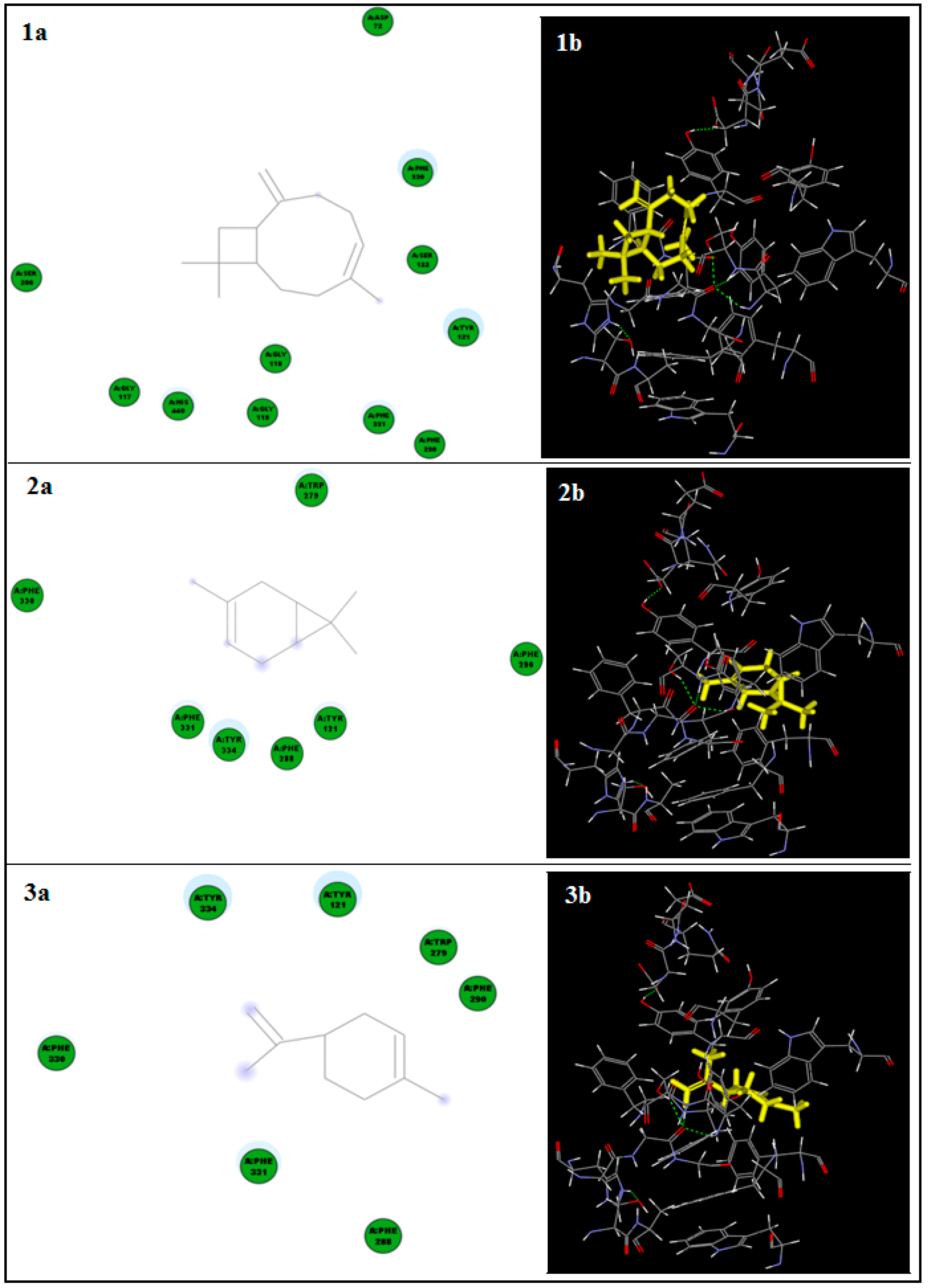Neuroprotective Effects of Black Pepper Cold-Pressed Oil on Scopolamine-Induced Oxidative Stress and Memory Impairment in Rats
Abstract
:1. Introduction
2. Materials and Methods
2.1. Plant Material and Chemicals
2.2. Clevenger Apparatus, Hydrodistilled and Cold-Pressed Oil
2.3. GC–MS Analysis
2.4. Experimental Animals
2.5. Experimental Design
2.6. Morris Water Maze and Passive Avoidance Tests
2.7. Rat Brain Sample Preparation and Histopathology
2.8. Neurochemical Parameters
2.9. Molecular Docking Study
2.10. Statistical Analyses
3. Results
3.1. Behavioral Study
3.2. Neurochemical Study
3.3. Histopathology Studies
3.4. Chemical Composition of the Oils
3.5. Molecular Docking Study
4. Discussion
5. Conclusions
Supplementary Materials
Author Contributions
Funding
Institutional Review Board Statement
Informed Consent Statement
Data Availability Statement
Acknowledgments
Conflicts of Interest
References
- Goverdhan, P.; Sravanthi, A.; Mamatha, T. Neuroprotective effects of meloxicam and selegiline in scopolamine-induced cognitive impairment and oxidative stress. Int. J. Alzheimers Dis. 2012, 2012, 974013. [Google Scholar] [CrossRef] [Green Version]
- Jewart, R.D.; Green, J.; Lu, C.J.; Cellar, J.; Tune, L.E. Cognitive, behavioral, and physiological changes in Alzheimer disease patients as a function of incontinence medications. Am. J. Geriatr. Psychiatry 2005, 13, 324–328. [Google Scholar] [CrossRef] [PubMed]
- Todirascu-Ciornea, E.; El-Nashar, H.A.S.; Mostafa, N.M.; Eldahshan, O.A.; Boiangiu, R.S.; Dumitru, G.; Hritcu, L.; Singab, A.N.B. Schinus terebinthifolius essential oil attenuates scopolamine-induced memory deficits via cholinergic modulation and antioxidant properties in a zebrafish model. Evid. Based Complement. Alternat. Med. 2019, 2019, 5256781. [Google Scholar] [CrossRef] [Green Version]
- Grossberg, G.T.; Tony, G.; Burke, A.D.; Tariot, P.N. Present algorithms and future treatments for Alzheimer’s disease. J. Alzheimers Dis. 2019, 67, 1151–1171. [Google Scholar] [CrossRef] [PubMed]
- Tang, K.S. The cellular and molecular processes associated with scopolamine-induced memory deficit: A model of Alzheimer’s biomarkers. Life Sci. 2019, 233, 116695. [Google Scholar] [CrossRef]
- Lee, J.S.; Hong, S.S.; Kim, H.G.; Lee, H.W.; Kim, W.Y.; Lee, S.K.; Son, C.G. Gongjin-Dan enhances hippocampal memory in a mouse model of scopolamine-induced amnesia. PLoS ONE 2016, 11, e0159823. [Google Scholar] [CrossRef] [PubMed] [Green Version]
- Elkhawas, Y.A.; Elissawy, A.M.; Elnaggar, M.S.; Mostafa, N.M.; Kamal, E.M.; Bishr, M.M.; Singab, A.N.B.; Salama, O.M. Chemical diversity in species belonging to soft coral genus Sacrophyton and its impact on biological activity: A review. Mar. Drugs 2020, 18, 41. [Google Scholar] [CrossRef] [Green Version]
- Noori, T.; Dehpour, A.R.; Sureda, A.; Sobarzo-Sanchez, E.; Shirooie, S. Role of natural products for the treatment of Alzheimer’s disease. Eur. J. Pharmacol. 2021, 898, 173974. [Google Scholar] [CrossRef] [PubMed]
- Bui, T.T.; Nguyen, T.H. Natural product for the treatment of Alzheimer’s disease. J. Basic Clin. Physiol. Pharmacol. 2017, 28, 413–423. [Google Scholar] [CrossRef] [PubMed]
- Mostafa, N.M. β-Amyrin rich Bombax ceiba leaf extract with potential neuroprotective activity against scopolamine-induced memory impairment in rats. Rec. Nat. Prod. 2018, 12, 480. [Google Scholar] [CrossRef]
- Hritcu, L.; Noumedem, J.A.; Cioanca, O.; Hancianu, M.; Postu, P.; Mihasan, M. Anxiolytic and antidepressant profile of the methanolic extract of Piper nigrum fruits in beta-amyloid (1-42) rat model of Alzheimer’s disease. Behav. Brain Funct. 2015, 11, 13. [Google Scholar] [CrossRef] [Green Version]
- Subedee, L.; Suresh, R.N.; Mk, J.; Hl, K.; Am, S.; Vh, P. Preventive role of Indian black pepper in animal models of Alzheimer’s disease. J. Clin. Diagn. Res. 2015, 9, FF01–FF04. [Google Scholar] [CrossRef] [PubMed]
- Dorman, H.J.; Deans, S.G. Antimicrobial agents from plants: Antibacterial activity of plant volatile oils. J. Appl. Microbiol. 2000, 88, 308–316. [Google Scholar] [CrossRef] [PubMed]
- Vijayakumar, R.S.; Surya, D.; Nalini, N. Antioxidant efficacy of black pepper (Piper nigrum L.) and piperine in rats with high-fat diet induced oxidative stress. Redox Rep. 2004, 9, 105–110. [Google Scholar] [CrossRef] [Green Version]
- El Hamss, R.; Idaomar, M.; Alonso-Moraga, A.; Munoz Serrano, A. Antimutagenic properties of bell and black peppers. Food Chem. Toxicol. 2003, 41, 41–47. [Google Scholar] [CrossRef]
- Lee, J.-G.; Chae, Y.; Shin, Y.; Kim, Y.-J. Chemical composition and antioxidant capacity of black pepper pericarp. Appl. Biol. Chem. 2020, 63, 35. [Google Scholar] [CrossRef]
- Mittal, R.; Gupta, R.L. In vitro antioxidant activity of piperine. Methods Find. Exp. Clin. Pharmacol. 2000, 22, 271–274. [Google Scholar] [CrossRef] [PubMed]
- Egyptian Pharmacopoeia. General Organization for Governmental Printing Offices; Ministry of Health: Cairo, Egypt, 1984. [Google Scholar]
- El-Nashar, H.A.S.; Mostafa, N.M.; El-Badry, M.A.; Eldahshan, O.A.; Singab, A.N.B. Chemical composition, antimicrobial and cytotoxic activities of essential oils from Schinus polygamus (Cav.) cabrera leaf and bark grown in Egypt. Nat. Prod. Res. 2020, 1–4. [Google Scholar] [CrossRef] [PubMed]
- Ashmawy, A.; Mostafa, N.; Eldahshan, O. GC/MS analysis and molecular profiling of lemon volatile oil against breast cancer. J. Essent. Oil Bear. Plants 2019, 22, 903–916. [Google Scholar] [CrossRef]
- Mostafa, N.M. Antibacterial activity of ginger (Zingiber officinale) leaves essential oil nanoemulsion against the cariogenic Streptococcus mutans. J. Appl. Pharm. Sci. 2018, 8, 34–41. [Google Scholar]
- Adams, R.P. Identification of Essential Oil Components by Gas Chromatography/Mass Spectrometry, 4th ed.; Allured Publishing Corporation: Carol Stream, IL, USA, 2007. [Google Scholar]
- Ayoub, N.; Singab, A.N.; Mostafa, N.; Schultze, W. Volatile constituents of leaves of Ficus carica Linn. grown in Egypt. J. Essent. Oil Bear. Plants 2010, 13, 316–321. [Google Scholar] [CrossRef]
- Singab, A.N.; Mostafa, N.M.; Eldahshan, O.A.; Ashour, M.L.; Wink, M. Profile of volatile components of hydrodistilled and extracted leaves of Jacaranda acutifolia and their antimicrobial activity against foodborne pathogens. Nat. Prod. Commun. 2014, 9, 1007–1010. [Google Scholar] [CrossRef] [PubMed] [Green Version]
- Zhang, H.; Yao, M.; Morrison, R.A.; Chong, S. Commonly used surfactant, Tween 80, improves absorption of P-glycoprotein substrate, digoxin, in rats. Arch. Pharm. Res. 2003, 26, 768–772. [Google Scholar] [CrossRef] [PubMed]
- Kim, Y.; Kim, J.; He, M.; Lee, A.; Cho, E. Apigenin ameliorates scopolamine-induced cognitive dysfunction and neuronal damage in mice. Molecules. 2021, 26, 5192. [Google Scholar] [CrossRef] [PubMed]
- Bancroft, J.; Stevens, A. Theory and Practice of Histological Techniques; Churchill Livingstone: New York, NY, USA, 1996. [Google Scholar]
- Ellman, G.L.; Courtney, K.D.; Andres, V., Jr.; Feather-Stone, R.M. A new and rapid colorimetric determination of acetylcholinesterase activity. Biochem. Pharmacol. 1961, 7, 88–95. [Google Scholar] [CrossRef]
- Aebi, H. Catalase in vitro. Methods Enzymol. 1984, 105, 121–126. [Google Scholar] [PubMed]
- Nishikimi, M.; Appaji, N.; Yagi, K. The occurrence of superoxide anion in the reaction of reduced phenazine methosulfate and molecular oxygen. Biochem.Bioph. Res. Commun. 1972, 46, 849–854. [Google Scholar] [CrossRef]
- Ohkawa, H.; Ohishi, N.; Yagi, K. Assay for lipid peroxides in animal tissues by thiobarbituric acid reaction. Anal. Biochem. 1979, 95, 351–358. [Google Scholar] [CrossRef]
- Kaur, R.; Parveen, S.; Mehan, S.; Khanna, D.; Kalra, S. Neuroprotective effect of ellagic acid against chronically scopolamine-induced Alzheimer’s type memory and cognitive dysfunctions: Possible behavioural and biochemical evidences. Int. J. Prev. Med. Res. 2015, 1, 45–64. [Google Scholar]
- Jung, K.; Lee, B.; Han, S.J.; Ryu, J.H.; Kim, D.H. Mangiferin ameliorates scopolamine-induced learning deficits in mice. Biol. Pharm. Bull. 2009, 32, 242–246. [Google Scholar] [CrossRef] [PubMed] [Green Version]
- Kumoro, A.C.; Hasan, M.; Singh, H. Extraction of Sarawak black pepper essential oil using supercritical carbon dioxide. Arab. J. Sci. Eng. 2010, 35, 7–16. [Google Scholar]
- Morsy, N.F.; Abd El-Salam, E. Antimicrobial and antiproliferative activities of black pepper (Piper nigrum L.) essential oil and oleoresin. J. Essent. Oil Bear. Plants 2017, 20, 779–790. [Google Scholar] [CrossRef]
- Ramesh, B.; Sarma, V.U.M.; Kumar, K.; Babu, K.S.; Devi, P.S. Simultaneous determination of six marker compounds in Piper nigrum L. and species comparison study using High-Performance Thin-Layer Chromatography–Mass Spectrometry. J. Planar Chromat. 2015, 28, 280–286. [Google Scholar] [CrossRef]
- Chen, S.-X.; Yang, K.; Xiang, J.-Y.; Kwaku, O.R.; Han, J.-X.; Zhu, X.-A.; Huang, Y.-T.; Liu, L.-J.; Shen, S.-B.; Li, H.-Z.; et al. Comparison of chemical compositions of the Pepper EOs from different cultivars and their AChE inhibitory activity. Nat. Prod. Commun. 2020, 15, 1–6. [Google Scholar] [CrossRef]
- Khosravi-Farsani, N.; Mashhadi, A.B.M.; Amini-Farsani, Z.; Heydari, S.; Teimori, H. Antioxidant and antiglycation effects of scopolamine in rat liver cells. Der Pharm. Lett. 2016, 8, 169–174. [Google Scholar]
- Singab, A.N.; Ayoub, N.A.; Ali, E.N.; Mostafa, N.M. Antioxidant and hepatoprotective activities of Egyptian moraceous plants against carbon tetrachloride-induced oxidative stress and liver damage in rats. Pharm. Biol. 2010, 48, 1255–1264. [Google Scholar] [CrossRef]
- Du, C.N.; Min, A.Y.; Kim, H.J.; Shin, S.K.; Yu, H.N.; Sohn, E.J.; Ahn, C.W.; Jung, S.U.; Park, S.H.; Kim, M.R. Deer bone extract prevents against scopolamine-induced memory impairment in mice. J. Med. Food 2015, 18, 157–165. [Google Scholar] [CrossRef] [Green Version]
- Palle, S.; Neerati, P. Quercetin nanoparticles attenuates scopolamine-induced spatial memory deficits and pathological damages in rats. Bull. Fac. Pharm. Cairo Univ. 2017, 55, 101–106. [Google Scholar] [CrossRef] [Green Version]
- Wink, M. Evolutionary advantage and molecular modes of action of multi-component mixtures used in phytomedicine. Curr. Drug Metab. 2008, 9, 996–1009. [Google Scholar] [CrossRef] [PubMed]
- Yang, W.; Chen, Y.H.; Liu, H.; Qu, H.D. Neuroprotective effects of piperine on the 1-methyl-4-phenyl-1,2,3,6-tetrahydropyridine-induced Parkinson’s disease mouse model. Int. J. Mol. Med. 2015, 36, 1369–1376. [Google Scholar] [CrossRef] [Green Version]
- Pany, S.; Pal, A.; Sahu, P. Potential neuroprotective effect of piperine in pilocarpine-induced temporal lobe epilepsy. Indo. Am. J. Pharm. Res. 2016, 6, 4369–4375. [Google Scholar]
- Kiso, Y. Antioxidative roles of sesamin, a functional lignan in sesame seed, and it’s effect on lipid- and alcohol-metabolism in the liver: A DNA microarray study. Biofactors 2004, 21, 191–196. [Google Scholar] [CrossRef]
- Hong, L.; Liangliang, C.; Yi, W.; Juncheng, H.; Qin, W.; Xiaoxiang, Z. Anti-aging effect of sesamin and its mechanism of action. Curr.Top. Nutraceutical Res. 2012, 10, 173. [Google Scholar]
- Zhao, T.T.; Shin, K.S.; Lee, M.K. Effects of (-)-Sesamin on Memory Deficits in MPTP-lesioned Mouse Model of Parkinson’s Disease. Nat. Prod. Sci. 2016, 22, 246–251. [Google Scholar] [CrossRef] [Green Version]
- Zhao, T.T.; Shin, K.S.; Park, H.J.; Kim, K.S.; Lee, K.E.; Cho, Y.J.; Lee, M.K. Effects of (-)-sesamin on chronic stress-induced memory deficits in mice. Neurosci. Lett. 2016, 634, 114–118. [Google Scholar] [CrossRef]
- Baluchnejadmojarad, T.; Mansouri, M.; Ghalami, J.; Mokhtari, Z.; Roghani, M. Sesamin imparts neuroprotection against intrastriatal 6-hydroxydopamine toxicity by inhibition of astroglial activation, apoptosis, and oxidative stress. Biomed. Pharmacother. 2017, 88, 754–761. [Google Scholar] [CrossRef] [PubMed]
- Calleja, M.; Vieites, J.; Montero-Meterdez, T.; Torres, M.; Faus, M.; Gil, A.; Suárez, A. The antioxidant effect of β-caryophyllene protects rat liver from carbon tetrachloride-induced fibrosis by inhibiting hepatic stellate cell activation. Br. J. Nutr. 2013, 109, 394–401. [Google Scholar] [CrossRef]
- Dahham, S.S.; Tabana, Y.M.; Iqbal, M.A.; Ahamed, M.B.; Ezzat, M.O.; Majid, A.S.; Majid, A.M. The Anticancer, Antioxidant and Antimicrobial Properties of the Sesquiterpene β-Caryophyllene from the Essential Oil of Aquilaria crassna. Molecules 2015, 20, 11808–11829. [Google Scholar] [CrossRef]
- Yang, M.; Lv, Y.; Tian, X.; Lou, J.; An, R.; Zhang, Q.; Li, M.; Xu, L.; Dong, Z. Neuroprotective effect of beta-caryophyllene on cerebral ischemia-reperfusion injury via regulation of necroptotic neuronal death and inflammation: In vivo and in vitro. Front. Neurosci. 2017, 11, 583. [Google Scholar] [CrossRef] [PubMed]
- Viveros-Paredes, J.M.; Gonzalez-Castaneda, R.E.; Gertsch, J.; Chaparro-Huerta, V.; Lopez-Roa, R.I.; Vazquez-Valls, E.; Beas-Zarate, C.; Camins-Espuny, A.; Flores-Soto, M.E. Neuroprotective effects of beta-caryophyllene against dopaminergic neuron injury in a murine model of parkinson’s disease induced by MPTP. Pharmaceuticals 2017, 10, 60. [Google Scholar] [CrossRef] [PubMed] [Green Version]
- Chang, H.J.; Kim, J.M.; Lee, J.C.; Kim, W.K.; Chun, H.S. Protective effect of beta-caryophyllene, a natural bicyclic sesquiterpene, against cerebral ischemic injury. J. Med. Food 2013, 16, 471–480. [Google Scholar] [CrossRef] [PubMed]
- Aazza, S.; Lyoussi, B.; Miguel, M.G. Antioxidant and antiacetylcholinesterase activities of some commercial essential oils and their major compounds. Molecules 2011, 16, 7672–7690. [Google Scholar] [CrossRef] [PubMed] [Green Version]
- Emami, S.A.; Asili, J.; Malekian, M.; Hassanzadeh, M. Antioxidant effects of the essential oils of different parts of Platycladus orientalis L. (Franco) and their components. J. Essent. Oil Bear. Plants 2013, 14, 334–344. [Google Scholar] [CrossRef]
- Miyazawa, M.; Yamafuji, C. Inhibition of acetylcholinesterase activity by bicyclic monoterpenoids. J. Agric. Food Chem. 2005, 53, 1765–1768. [Google Scholar] [CrossRef] [PubMed]






| No. | Compound a | RI Calculated | RI Reported | % Composition | Method of Identification | |
|---|---|---|---|---|---|---|
| HDO | CPO | |||||
| 1. | α-Thujene | 918 | 922 | 1.31 | nd | RI, MS |
| 2. | α-Pinene | 925 | 925 | 7.27 | nd | RI, MS |
| 3. | Camphene | 941 | 943 | 0.01 | nd | RI, MS |
| 4. | Sabinene | 971 | 975 | 21.36 | nd | RI, MS |
| 5. | β-Pinene | 974 | 979 | 15.53 | nd | RI, MS |
| 6. | β-Myrcene | 988 | 992 | 2.08 | nd | RI, MS |
| 7. | α-Phellandrene | 1002 | 1007 | 0.36 | nd | RI, MS |
| 8. | 3-Carene | 1008 | 1011 | 0.77 | 9.53 | RI, MS |
| 9. | 2-Carene | 1015 | 1014 | 0.43 | nd | RI, MS |
| 10. | p-Cymene | 1023 | 1025 | 0.07 | nd | RI, MS |
| 11. | Limonene | 1029 | 1032 | 26.50 | 6.23 | RI, MS |
| 12. | Eucalyptol | 1031 | 1031 | 0.07 | nd | RI, MS |
| 13. | cis-β-Ocimene | 1037 | 1037 | 0.02 | nd | RI, MS |
| 14. | trans-β-Ocimene | 1047 | 1050 | 0.15 | nd | RI, MS |
| 15. | γ-Terpinene | 1058 | 1060 | 1.15 | nd | RI, MS |
| 16. | cis-Sabinene hydrate | 1067 | 1067 | 0.24 | nd | RI, MS |
| 17. | Terpinolene | 1087 | 1089 | 0.27 | nd | RI, MS |
| 18. | β-Linalool | 1100 | 1100 | 0.69 | nd | RI, MS |
| 19. | Terpinene-4-ol | 1178 | 1177 | 0.59 | nd | RI, MS |
| 20. | α-Terpineol | 1191 | 1190 | 0.02 | nd | RI, MS |
| 21. | δ-EIemene | 1340 | 1337 | 0.07 | nd | RI, MS |
| 22. | α-Copaene | 1379 | 1377 | 0.17 | nd | RI, MS |
| 23. | cis-α-Bergamotene | 1418 | 1415 | 0.10 | nd | RI, MS |
| 24. | β-Caryophyllene | 1427 | 1428 | 19.12 | 10.67 | RI, MS |
| 25. | trans-α-Bergamotene | 1438 | 1435 | 0.18 | nd | RI, MS |
| 26. | (E)-β-Famesene | 1457 | 1456 | 0.06 | nd | RI, MS |
| 27. | α-Humulene | 1460 | 1453 | 0.10 | nd | RI, MS |
| 28. | Isocaryophyllene | 1489 | 1494 | 0.02 | nd | RI, MS |
| 29. | α-Selinene | 1493 | 1493 | 0.02 | nd | RI, MS |
| 30. | α-Zingiberene | 1499 | 1495 | 0.14 | nd | RI, MS |
| 31. | Valencene | 1502 | 1496 | 0.02 | nd | RI, MS |
| 32. | β-Bisabolene | 1512 | 1508 | 0.33 | nd | RI, MS |
| 33. | δ-Cadinene | 1529 | 1523 | 0.07 | nd | RI, MS |
| 34. | α-Farnesene | 1536 | 1538 | 0.19 | nd | RI, MS |
| 35. | Caryophyllene oxide | 1591 | 1593 | 0.16 | nd | RI, MS |
| 36. | Piperine | 2915 | 2933 | nd | 33.79 | RI, MS, (SI = 94) |
| 37. | Sesamin | 3145 | 3151 | nd | 39.78 | RI, MS, (SI = 92) |
| Total | 99.64% | 100% | ||||
Publisher’s Note: MDPI stays neutral with regard to jurisdictional claims in published maps and institutional affiliations. |
© 2021 by the authors. Licensee MDPI, Basel, Switzerland. This article is an open access article distributed under the terms and conditions of the Creative Commons Attribution (CC BY) license (https://creativecommons.org/licenses/by/4.0/).
Share and Cite
Mostafa, N.M.; Mostafa, A.M.; Ashour, M.L.; Elhady, S.S. Neuroprotective Effects of Black Pepper Cold-Pressed Oil on Scopolamine-Induced Oxidative Stress and Memory Impairment in Rats. Antioxidants 2021, 10, 1993. https://doi.org/10.3390/antiox10121993
Mostafa NM, Mostafa AM, Ashour ML, Elhady SS. Neuroprotective Effects of Black Pepper Cold-Pressed Oil on Scopolamine-Induced Oxidative Stress and Memory Impairment in Rats. Antioxidants. 2021; 10(12):1993. https://doi.org/10.3390/antiox10121993
Chicago/Turabian StyleMostafa, Nada M., Ahmed M. Mostafa, Mohamed L. Ashour, and Sameh S. Elhady. 2021. "Neuroprotective Effects of Black Pepper Cold-Pressed Oil on Scopolamine-Induced Oxidative Stress and Memory Impairment in Rats" Antioxidants 10, no. 12: 1993. https://doi.org/10.3390/antiox10121993








